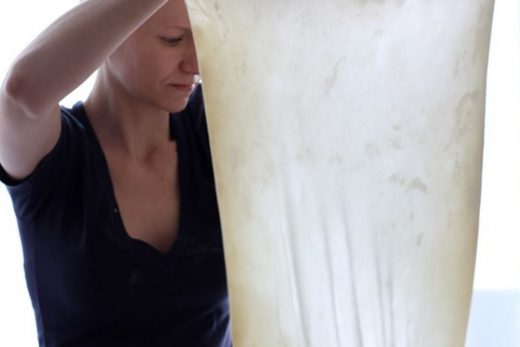Proper bulk fermentation means giving dough enough time (at a given temperature) to ferment. Under- or over-proofing leads to suboptimal results: An under-proofed dough can be dense and have an uneven crumb while an over-proofed dough can be hard to handle and feature an overly tight crumb structure.
How do you know when bulk fermentation is complete? It’s difficult to answer definitively. Remember, you’re going to be baking your bread in a ripping hot oven. That blast of heat encourages rapid metabolism of starches—a feeding frenzy—and expansion of the dough. If you vastly overproof your dough, those trapped gas bubbles coalesce into a tight network and stick to each other, resulting in an overly tight crumb structure; at worst, the dough collapses. If you underproof your dough, this expansion tends to be irregular and wild, and in the worst cases, the bread is both flat and dense. Generally, Kristen aims for a 60 percent increase in size. But a 60 percent increase is difficult to track visually. When you factor in folding and de-gassing of the dough, visual identification becomes even harder. Instead, she recommends bulk fermenting for a set amount of time, and adjusting that time as needed over successive bakes.*
*If you want to be more precise, there is a way to track 60 percent rise. Kristen employs a small jar and feeds a small amount of starter into that jar as soon as she incorporates the levain into her dough. Left undisturbed at the same fermenting temperature as her dough, this “aliquot jar” provides a reasonably reliable method to measure a 60 percent rise in volume.
“New bakers aren’t going to know what to look for,” says Kristen. “Say I had the same starter, I had the same temperature, and I bulked for five hours. [The loaf] didn’t turn out how I wanted it to. Next time, I bulked for six hours, and now it looks a little better. Same thing for seven hours. It’s not something you can do over one bake. It has to be done over many bakes, [using] side-by-side comparisons.”
Still, it’s helpful to provide some visual cues. A properly “bulked” dough will be slightly rounded at the top and edges; it will be bubbly on the surface and jiggle slightly when shaken; finally, it should release from the bowl or container relatively easily before shaping. Some bakers use the “finger poke test” to roughly determine level of proof: If you poke a dough, and the indentation springs back quickly or too fast, the dough is underproofed; if the indentation stays or doesn’t change at all, the dough is overproofed; and if the indentation slowly springs back to its original shape, the dough is just right.





